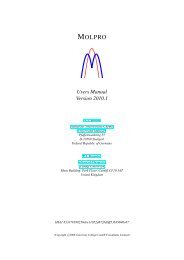CHAPTER II. POTENTIOMETRY AND REDOX TITRATIONS I ...
CHAPTER II. POTENTIOMETRY AND REDOX TITRATIONS I ...
CHAPTER II. POTENTIOMETRY AND REDOX TITRATIONS I ...
- No tags were found...
Create successful ePaper yourself
Turn your PDF publications into a flip-book with our unique Google optimized e-Paper software.
MnO − 4 + 4H + + 3e = MnO 2 (s) + 2H 2 O E° = 1.692 Vbrown(manganese dioxide)In strongly alkaline solution (2 M NaOH),MnO − 2−4 + e = MnO 4 E° = 0.56 Vgreen(manganate)KMnO 4 usually serves as its own indicator. If the titrant is too dilute to be seen, anindicator such as ferroin can be used.Preparation and Standardization:KMnO 4 is not a primary standard. Aqueous KMnO 4 is unstable by virtue of thereaction4MnO − 4 + 2H 2 O = 4MnO 2 (s) + 3O 2 + 4OH −which is slow in the absence of MnO 2 , Mn 2+ , heat, light, acids, and bases andshould be stored in a dark glass bottle.KMnO 4 can be standardized by titration of sodium oxalate (Na 2 C 2 O 4 ).2MnO − 4 + 5H 2 C 2 O 4 + 6H + = 2Mn 2+ + 10CO 2 + 8H 2 Ob) Oxidation with Cerium(IV)Ce 4+ + e = Ce 3+ E° = 1.44 V (in 1 M H 2 SO 4 )Ce 4+ is yellow and Ce 3+ is colorless, but the color change is not distinct enough forcerium to be its own indicator.The oxidizing strengths of KMnO 4 and Ce 4+ are comparable, but Ce 4+ in sulfuricacid is very stable.Primary-standard-grade salt of Ce(IV) is available.c) Oxidation with Potassium DichromateIn acidic solution,Cr 2 O 2− 7 + 14H + + 6e = 2Cr 3+ + 7H 2 OE° = 1.36 V11











![Hetero [6+3] Cycloaddition of Fulvenes with N-Alkylidene Glycine ...](https://img.yumpu.com/35423358/1/190x245/hetero-6-3-cycloaddition-of-fulvenes-with-n-alkylidene-glycine-.jpg?quality=85)




